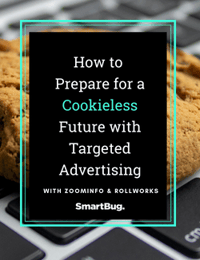
Prepare to Go Cookieless: Marketing Strategies for Evergreen ROI
October 29, 2021
The other day I answered a phone call from a local Mazda dealership asking if I was still interested in a CX-5. I told them the same story: Maybe one day I’ll need a new car, but that day is not today.
Then the salesperson asked me something that still weirds me out: “So how did you like your trip to SeaWorld?” I had clicked on a Mazda offer shortly after using my company’s discount site to buy tickets. For a good while after that, I felt like I saw Mazda advertisements on every site I visited. His question had me wondering what else is being done with my information.
My story isn’t unique—you click on a product or visit a website, and now you’re seeing ads for it everywhere. Tracking data is getting more and more intrusive (in some cases bordering on Big Brother-esque), so the deprecation of cookie tracking seems like a refreshing change.
As a consumer, I am living for the great third-party cookie phase out. As a marketing professional, I’m worried about losing the data that helps me do my job and preparing for the shift to a “cookieless” (but only partially cookieless) future. The upside? Everyone in the industry understands that stagnant strategy ends engagement.
A cookieless future is not a marketing data apocalypse. This is a great opportunity for companies to build a more organic form of trust (and better engagement metrics) with their clients.
So let’s look at how you can prepare your marketing strategy for a cookieless future today.
The Cookies That Define Our Digital Experience
Before we can take a deep dive into the deprecation of cookies, it’s important that we take a look at the cookies on the market today. To understand what exactly we’re doing away with, you need to understand the difference between first- and third-party cookies.
First-Party Cookies
First-party cookies are the data that is collected when you are on a website. Think about when you visit an ecommerce website: When you land on the site, your browser sends a message to the website’s server, indicating that you are the direct source the site should interact with. That’s why you’re able to stay signed into your account and why the items in your shopping cart are waiting for you when you get back to a site.
First-party cookies only collect the data needed to provide a good user experience. Once you leave the website, your data is no longer being tracked by first-party cookies. First-party cookie tracking is not going away.
Third-Party Cookies
Third-party cookies collect user data, but they are not hosted on that website’s server. They are used on any site that loads the third party’s code. Think about when you click on an advertisement on Instagram or a seller’s item on Amazon. Amazon and Instagram may not be tracking you once you sign out, but the third-party cookies associated with what you’ve clicked are still tracking you once you’ve logged off.
That’s why you’re hit with the same advertisements across your devices and searches: The third-party cookies are still tracking you. They’ve determined where you are and where you will be, and they consistently retarget in an effort to keep their brand in your brain. Third-party cookies are what will be going away once Google has joined the cookie deprecation train.
The Value of Tracking Data
I’m going to address the elephant in the room and say that third-party cookies aren’t necessarily a bad thing. They exist to create a richer picture of a user which, in turn, allows a company to retarget messaging in a way that’s convenient for the consumer. They provide deterministic data that tells companies exactly where their buyers are going and what their interests are, so they see a message tailored to them exactly.
On the other hand, third-party advertising has gotten pretty creepy and intrusive, if it isn’t done tactfully. Some companies have come to rely on third-party data to keep injecting their message into a consumer’s day whether they like it or not. Furthermore, this has started a wave of lazy marketing strategies—why try to connect with your buyer when you already know where they are?
Laws like the General Data Protection Regulation (GDPR) and the California Consumer Privacy Act set the stage for protecting user privacy, and deprecating third-party cookies is another way for companies to protect user data from being exploited. Users crave connection, not targeting. They want to build trust, not be force-fed a message.
So is this the end? Are we going to have to rip out and replace our marketing strategy to live with a cookieless future?
Not really. It’s important to remember that targeting isn’t going anywhere. Rather, our approach to targeting our audience will look a little different. Without the deterministic data that third-party targeting provides, we’ll rely on probabilistic data instead.
Let’s take a look at some ways companies can prepare for the deprecation of third-party cookies.
How Can You Prepare Your Marketing Strategy for a Cookieless Future?
Industry professionals should start by going into the fundamentals of marketing. Learn your audience, segment them, and target the users who stand to gain the most from what you’re offering.
This sounds really basic, and that’s because it is—before we used third-party tracking to find consumers, we built brand profiles based on research and understanding. We can still measure, test, adjust, and repeat on a continuous cycle to build awareness, foster consideration, drive a decision, and build a following.
1. Account-Based Marketing
Companies should already be creating more personalized messaging in order to build trust by earning trust. Which brings me to another strategy to lean into: account-based marketing (ABM).
ABM kickstarts the inbound flywheel by finding the specific audience you want to target and funneling your efforts into creating and delivering highly personalized messaging that appeals to your target audience. You break down data silos between sales and marketing and align to create the ideal buyer from the perfect company and tailor your messaging to them. No cookies, just connection.
2. Contextual Marketing
Another marketing strategy to try is contextual marketing. Build your website for your audience and use dynamic modules to show each visitor content applicable to them. Buyers like to feel heard, so when you are providing offers in context with the stage they are in or the probabilistic data cohort they represent, your ability to reach and captivate your audience feels more organic than forced.
If you’re going to try contextual marketing, the key is to start slow. Remember that buyers appreciate personalization to an extent. Therefore, it’s nice for a return user to see a “welcome back” banner, but if it’s their first time on your site, their experience should convey “nice to meet you” messaging.
3. Optimize Your Tech Stack
Your marketing technology (MarTech) stack should work like a symphonic orchestra: Each section has its own part to play, but the real music happens when they work together. Audit your current tech stack to determine what tools are working and how they are working together.
Start with your content management system (CMS)—and remember that your CMS isn’t a repository for content. It should be tied into your marketing process. Ensure the user data you have in your customer relationship management (CRM) platform is clean and up-to-date.
Your ad tech is going to be more important than ever. Find out how any third-party cookies are being used so you’re able to pivot your advertisement strategy accordingly.
Finally, your user experience (UX) is going to be far more important than it’s ever been. Using your UX and user interface (UI) tools to ensure you understand your users’ experience and determining where you can add value is another way to optimize your UX.
4. Make the Most of What You Have Now
We still have some time with third-party cookies, so use the data before you lose it. Learn where you’re already using third-party data tracking and build a first-party data strategy to mitigate the effects of losing that data. Be responsible, and remember what third-party tracking is: a powerful tool that serves marketers and audiences. It’s not jarring personalization; it's about gaining relevant insight into your target audience.
How to Cope Without Cookies
There’s no silver bullet—no way to fully address what to do to prepare for a cookieless future—because no one has the right answers about how to approach a cookieless future right now. Remember that everyone will be affected by this in one way or another, so you are not alone. In fact, during the “How to Prepare for a Cookieless Future with Targeted Advertising” webinar by SmartBug® (now available on demand), 69 percent of respondents said they’re kind of prepared while 24 percent admitted that they weren’t aware that cookie tracking was going away.
Therefore, the best thing to do is get informed on the state of cookies. Even though Google will be done with third-party cookies, you’re going to be able to reach targeted audiences one way or another. By just being a good marketer with an ethical marketing strategy, you can start laying the foundation to succeed despite any changes thrown your way.
Also, for the record: My trip to SeaWorld was fantastic.

About the author
Brittany Glasscock was formerly a Marketing Specialist at SmartBug based in The Woodlands, Texas. She started her career in the K-12 industry and transitioned into content marketing for a B2B SaaS company. When she's not rocking awesome inbound strategies for clients, she runs (poorly), travels as much as possible, and tries not to burn her kitchen down while cooking. Read more articles by Brittany Glasscock.









